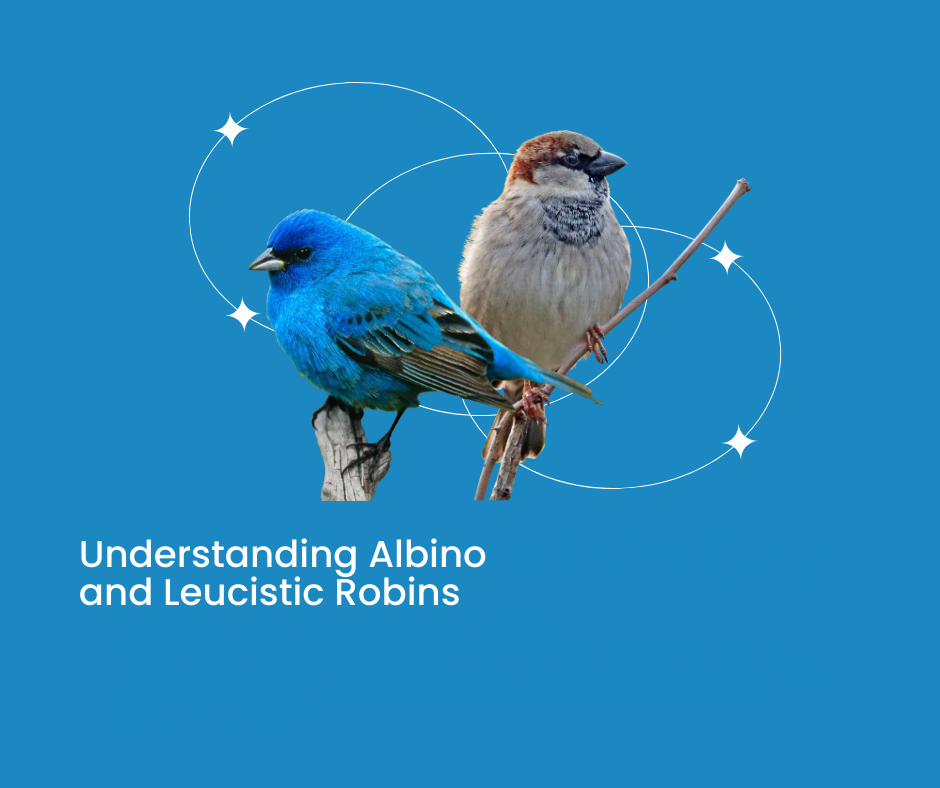Are Albino and Leucistic Robins Rare?
Bird enthusiasts often find it exciting to spot a robin with unusual plumage, such as Albino and Leucistic robins. While these robins are certainly unique and visually striking, they are not as rare as some may think. Let’s explore the differences between these two conditions and how frequently they occur in robins.
Understanding Albino and Leucistic Robins
- Albino Robins:
- Albinism is a genetic condition where a bird has no pigmentation, leading to white feathers and red or pink eyes due to a lack of melanin. While albino robins are not extremely common, they can occur in the wild. These robins stand out because of their all-white plumage, making them easily noticeable.
- Leucistic Robins:
- Leucism is another genetic variation that results in reduced pigmentation but does not completely eliminate it. Leucistic robins typically have lighter feathers compared to normal robins, often showing pale or patchy white feathers with some normal coloration. Unlike Albino and Leucistic birds have dark eyes.

How Rare Are These Robins?
While spotting an Albino and Leucisticrobin is an unusual and exciting event, these birds are not considered extremely rare. Leucistic robins are more commonly spotted than albino robins, as the condition of partial pigmentation loss occurs more frequently in nature.
Despite being uncommon, these birds’ distinctive appearance makes them highly sought after by bird watchers and photographers, adding to their mystique.
Read more: How Rare Are These Robins
Conclusion
Although albino and leucistic robins are certainly rare and special to see, they are not as rare as some might believe. Leucism in robins is more common than albinism, but both types are relatively rare occurrences in the wild. These birds’ unusual appearance serves as a reminder of the natural variations that make wildlife so fascinating.
White Robins: Albino and Leucistic?
When it comes to rare robins with unusual plumage, albino and leucistic robins are often mistaken for one another. Both types are characterized by lighter-colored feathers, but they have distinct differences. Let’s explore what makes these white robins stand out and how to identify them.
Leucistic American Robin
A leucistic robin exhibits partial loss of pigmentation, resulting in white patches or lighter feathers scattered across its body. Unlike true albino robins, these birds retain some natural color, especially in their eyes. Leucism results in a more patchy white appearance, which distinguishes these birds from fully albino ones.
One observer, Susan Jacobsen from New Berlin, Wisconsin, noted the presence of a white robin for three consecutive years, wondering if it was the same bird. Leucism in robins is rare, but it’s not uncommon for certain birds to return to the same locations year after year.
Read more: Leucistic American Robin
Albino Robins
An albino robin is a rarer sight. These robins lack all pigmentation, leading to a completely white body and pink or red eyes. Albinism, unlike leucism, results in the complete absence of color, and the bird’s eyes are typically red due to the lack of melanin.
How Rare Are These Robins?
While white robins are fascinating to observe, they are still quite rare. Leucism and albinism are both genetic conditions that affect a small percentage of the robin population, estimated to be around one in 30,000 robins.
However, it’s not unusual for the same bird to be seen over several years, as robins tend to be faithful to their locations and may return season after season.
also read: How Rare Are These Robins
Both Albino and Leucistic robins are rare, with leucistic robins being more commonly observed. These unique birds, while mostly white, are not albino but instead exhibit partial pigmentation loss due to leucism.
If you encounter one of these white robins, consider yourself fortunate, as these birds’ striking appearance makes them a remarkable sight in nature.
Understanding Leucistic Robins
Many bird watchers may encounter a robin with unusual plumage and wonder if it is a leucistic robin. For instance, Candy Brass from Grand Rapids, Michigan, asked, “Is this American robin leucistic?” The answer, in this case, is yes. What makes this robin unique is that its feathers show signs of leucism, not albinism.

What is Leucism in Robins?
Leucism refers to a condition where a bird loses some or all of its pigmentation, resulting in lighter or white feathers. However, unlike albino birds, a leucistic robin retains some color—such as black eyes and a yellow bill—which distinguishes it from a true albino robin that would have red eyes and no pigment at all.
In this case, the robin still displays some of the typical colors, like orange and gray, but they are significantly reduced.
How Rare Are Leucistic Robins?
While leucism is not unheard of in American robins, it is still a relatively rare condition. The sight of a leucistic robin is special because such birds are uncommon and a delightful sight for bird watchers.
Their mostly white plumage and partial color loss make them stand out from the typical robin, which is characterized by its bright red breast and more vibrant colors.
Summary
Leucistic robins are rare but not unheard of. The condition causes a robin to lose much of its typical pigment, resulting in a bird with lighter plumage but not a complete lack of color. While leucism is a fascinating phenomenon, it is a rare and unique experience to spot a Albino and Leucistic robin in the wild, making it a special treat for bird enthusiasts.
Sightings of Leucistic Robins
Leucistic robins are a rare and fascinating sight. Many bird watchers, like Martha Chavez, have shared their excitement after spotting a robin with partial albinism. Martha describes how she was “mesmerized” by the appearance of a leucistic robin in the fall, only to be delighted when the bird returned in the following spring.
This phenomenon of a robin with lighter plumage—often described as partial albino—is a special and memorable experience for those fortunate enough to witness it.
Is It Worth Watching a Robin?
For bird enthusiasts, spotting a Albino and Leucistic is an extraordinary event. Sue Moore, another bird watcher, recounts a spring morning in Minnesota when she noticed a flash of white. After investigating, she realized it was a male robin with partial albinism.
The bird remained in the area for over a week, perched on treetops and singing, making it a unique sight for Sue. These rare moments highlight the beauty and intrigue of nature, as leucistic robins stand out due to their unusual plumage.
Conclusion
Though rare, sightings of Albino and Leucistic robins offer an unforgettable experience for bird watchers. These birds, with their strikingly lighter feathers, are not only a visual marvel but also serve as a reminder of the diversity in nature. Whether in the fall or spring, encountering one of these robins is a true birdwatching highlight.